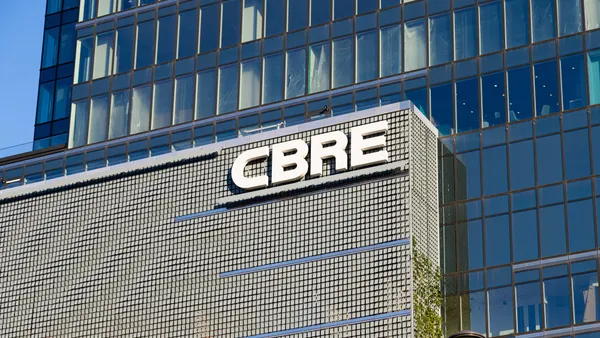Dive Brief:
- JLL recorded $5.6 billion in revenue in the second quarter of 2024, an 11% year-over-year increase driven by a strong contribution from its Work Dynamics business, the firm reported Tuesday.
- Revenue in the Work Dynamics segment rose 17% year over year in the second quarter to $3.9 billion, fueled by an 18% year-over-year increase in its workplace management business, which reached a little over $3 billion in revenue, the firm reported Tuesday. In the first half of 2024, workplace management revenue rose 17% year over year to nearly $5.9 billion, JLL said.
- “Within workplace management, we continue to add clients and expand existing mandates, supporting a solid long-term growth trajectory,” JLL CFO Karen Brennan said on an earnings call Tuesday. “[We] will begin lapping the benefit of the 2023 wins in the third quarter and more meaningfully in the fourth quarter of this year.”
Dive Insight:
Revenue from JLL’s resilient businesses collectively rose 16% in local currency, according to JLL’s earnings release. JLL defines these businesses as workplace management within Work Dynamics, property management within Markets Advisory, value and risk advisory and loan servicing within Capital Markets, JLL Technologies and advisory fees within LaSalle.
Within JLL’s Work Dynamics business, project management revenue rose 12% year over year to $788 million in the second quarter and climbed 5% year over year to $1.4 billion in the first half of 2024, according to the firm’s earnings release. The firm attributed the increase in project management revenue to growth in the Americas and Asia-Pacific, “where higher pass-through costs drove the increase in revenue and management fees increased low single digits.”
Within JLL’s Markets Advisory segment, property management revenue grew 7% year over year to $436.6 million in the second quarter and $866.3 million in the first half of 2024. Leasing revenue grew 5% year over year to $619.1 million in the second quarter, led by improvement in the office sector, and 4% year over year to $1.1 billion in the first half of 2024, JLL said.
Leasing’s second-quarter growth was driven by growth across most geographies, “notably in the U.S. Greater China, India and Germany” and increased deal size and transaction volumes in the office sector, partially offset by lower deal size and volumes in the industrials sector, Brennan said on the call.
“In the U.S. active tenant requirements were stable from Q1 and up from last year with new requirements outpacing executed transactions during the quarter, which should lead to a continued [rise] in activity,” JLL president and CEO Christian Ulbrich said on the call.
While global office leasing volumes increased by 10% in the second quarter, the surge was more pronounced in the U.S. at 19%, driven by an improving economic outlook and stabilizing hybrid work policies, even as new groundbreakings for U.S. office buildings have reached their “lowest level on record,” according to JLL’s earnings presentation.
“We continue to see more sustained leasing demand for high-quality assets and large office deals increased from a year ago, both of which are favorable for our business mix,” Brennan added.
In the industrials sector, however, gross leasing volumes across North America shrank 40% year over year in the second quarter, contributing to subdued global activity in the industrial leasing space, per JLL’s earnings presentation. Although rental growth remains positive, it is starting to level out amid pressures from increased supply and higher vacancy rates, the firm said in its presentation.
“There is still positive demand in industrial and the overall secular trends around industrial, particularly in the U.S., remains strong. The vacancy rate is only at 6.6%,” Brennan noted. “We are still seeing some pockets of strength. The key industries where we’re seeing the highest leasing volume are energy and utilities, advanced manufacturing and e-commerce uses.”
Revenue for JLL Technologies fell 7% year over year to $56.4 in the second quarter and declined 10% year over year to $110.3 million in the first half of 2024, according to JLL’s earnings release. “Lower bookings over the past few quarters as well as client decisions to delay projects were the primary drivers of the 7% decline in revenue,” Brennan said. “While we expect these trends to continue to pressure growth in the near term, we are encouraged by the long-term growth opportunity of our technology business.”
“Regarding our 2024 full year financial outlook, growth trends in our more resilient business lines collectively remain solid. Considering our pipeline activity and general improvement in a number of key market drivers,” Brennan said. “We are cautiously optimistic for an acceleration in transaction activity in the back half of the year.”
“In leasing, we are expecting global activity to continue improving for the remainder of the year,” Ulbrich said.














